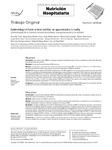Epidemiology of home enteral nutrition: an approximation to reality

Use this link to cite
http://hdl.handle.net/2183/37623
Except where otherwise noted, this item's license is described as Atribución-NoComercial-CompartirIgual 3.0 España
Collections
- Investigación (FEP) [514]
Metadata
Show full item recordTitle
Epidemiology of home enteral nutrition: an approximation to realityAlternative Title(s)
Epidemiología de la nutrición enteral domiciliaria: una aproximación a la realidadAuthor(s)
Date
2018-05Citation
Villar Taibo R, Martínez Olmos MÁ, Bellido Guerrero D, Vidal Casariego A, Peinó García R, Martís Sueiro A, Camarero González E, Ríos Barreiro V, Cao Sánchez P, Durán Martínez R, Rodríguez Iglesias MJ, Rodríguez Blanco B, Rojo Valdés J. Epidemiology of home enteral nutrition: an approximation to reality. Nutr Hosp. 2018 Jun 7;35(3):511-518. English. doi: 10.20960/nh.1799. PMID: 29974755.
Abstract
[Abstract] Introduction: home enteral nutrition (HEN) has undergone an important development; however, there is a notable lack of information with regard
to its incidence and characteristics.
Objectives: our aim was to assess the state of HEN in our area.
Methods: an observational, prospective study, involving all patients who had initiated HEN in the Nutrition Unit during a year. Epidemiological,
functional, and nutritional evolution of the patients was described and incidence of HEN was calculated.
Results: HEN incidences totalled 229/100,000 inhabitants/year. The HEN population in our area was characterized by the aged and a high
frequency of comorbidity and functional limitations. Neurological and oncological diseases accounted for 50% of indications. The remaining cases
were malnourished patients who had received short periods of HEN after hospitalization or a hip fracture. Oral supplements (60%) with standard
and hypercaloric formulas were used the most. At baseline, 75% of the patients suffered from malnutrition. During the follow-up, patients showed
weight gain (1.6%), an increase in the percentage of normal weight and overweight (from 74% to 82.7%, p = 0.001) and a reduction in pressure
ulcers (15.7% vs 10.3%, p < 0.001). The median duration of HEN was 8.5 months. Only a quarter of the patients experienced complications
(mostly mild gastrointestinal complications); 43.1% had died at the end of the follow-up.
Conclusions: in our area, the HEN incidence was much higher than those described in the literature. HEN appears to be a safe therapy with few
complications that improves the nutritional status of the patients, even with short periods of administration. [Resumen] Introducción: la nutrición enteral domiciliaria (NED) ha experimentado un importante desarrollo, aunque aún existe una notable carencia de
información acerca de su incidencia y características.
Objetivos: evaluar el estado de la NED en nuestra área.
Métodos: estudio observacional y prospectivo que incluyó a todos los pacientes que iniciaron NED en el periodo de un año. Describimos su
evolución epidemiológica, funcional y nutricional y calculamos la incidencia de NED.
Resultados: la incidencia de NED alcanzó los 229/100.000 habitantes/año. La población con NED se caracterizó por ser añosa, con una elevada
frecuencia de comorbilidad y limitación funcional. Las enfermedades neurológicas y oncológicas representaron el 50% de las indicaciones. El
resto fueron pacientes malnutridos que recibieron periodos cortos de NED tras una hospitalización o fractura de cadera. Los suplementos orales
con fórmulas estándar o hipercalóricas fueron los más utilizados (60%). Al inicio, el 75% de los pacientes tenía malnutrición. En el seguimiento,
los pacientes lograron aumento de peso (1,6%) y mayor porcentaje de normopeso o sobrepeso (de 74% a 82,7%, p = 0,001). Las úlceras
por presión se redujeron (15,7% vs. 10,3%, p < 0,001). La duración mediana de NED fue 8,5 meses. Solo una cuarta parte de los pacientes
experimentaron complicaciones, la mayoría de ellas gastrointestinales y leves. El 43,1% había fallecido al final del seguimiento.
Conclusiones: en nuestra área, la incidencia de NED es más elevada respecto a lo descrito en la literatura. La NED es un tratamiento seguro
con pocas complicaciones que mejora el estado nutricional de los pacientes, incluso con periodos cortos de administración
Keywords
Malnutrition
Nutritional support
Home enteral nutrition
Malnutrición
Soporte nutricional
Nutrición enteral domiciliaria
Nutritional support
Home enteral nutrition
Malnutrición
Soporte nutricional
Nutrición enteral domiciliaria
Editor version
Rights
Atribución-NoComercial-CompartirIgual 3.0 España
ISSN
1699-5198






